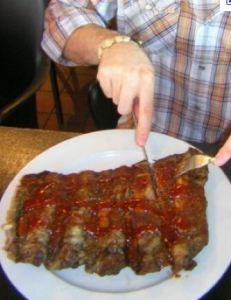Hello Everyone,
In this royonrescue blog entry I wanted to address a particularly familiar problem associated with sports of all kinds but especially common with high impact sports and the new uptick of people getting into Martial Arts, Judo, Brazillian Jiu-Jitsu and MMA. For anyone who has been involved in any of these sports you know that it takes a lot of time, energy, work, determination and discipline to get to a point where you’re not just trying to get into shape but trying to improve your game. All the months and years of training hard, working out and testing your skills all to have them come to a screeching hault when your fell a rib “pop”. This term “popped a rib” is coined for the explanation of any type of injury having to do with the rib cage but is mostly found in the anterior or posterior region of the lower rib cage, ie. floating or hanging ribs. These are the ribs that are low and out to the sides of the abdominal region. They are called hanging or floating due to the fact that they are not connected to the sternum and only the spine. Because of this feature they are usually very flexible and can take a lot of pressure. When a person gets hit hard, leans over a railing wrongly or maybe takes a punch, kick or a knee on stomach from another sparring partner or teammate, they can damage the rib causing everything from dull to severe pain.
Now when I say from dull to severe I mean from the scale of pain everthing from .5-10 on the scale. Some of this depends on the severity of the rib fracture and some of it depends on if it is an actual rib fracture or if it’s a muscle or cartilage injury. The pain can be only sensitive to pressure or additional bumps or it can hurt when a person breaths but either way, when the injury is present it definitely makes itself known and can really screw up sleep, let alone your normal training routine.
Because I couldn’t find a lot of good advice or explanation all in one location, I thought I’d add my two cents to the whole thing and maybe help someone out.
Question: Is a rib fracture dangerous?
RoyOnRescue Reply: It is not usually a dangerous injury unless the rib is fractured completely and sharp bone end punctures an organ or muscle. If the rib is broken from a wrong movement it is probably not as potentially dangerous as when it’s broken from a severe force. Severe force strong enough to break a rib high up in the chest cavity may be strong enough to cause trauma to lungs, heart or other parts of the body. At it’s worse here’s what trauma.org says about rib fractures: Fractures of the lower ribs may be associated with diaphragmatic tears and spleen or liver injuries. Injuries to upper ribs are less commonly associated with injuries to adjacent great vessels. This is especially true of a first rib fracture, which requires a significant amount of force to break and indicates a major energy transfer. A fracture of the first rib should prompt a careful search for other injuries. Note also that the rib cage and sternum provide a significant amount of stability to the thoracic spine. Severe disruption of this ‘fourth column’ may convert what would otherwise be a stable thoracic spine fracture into an unstable one.(http://www.trauma.org/index.php/main/article/399/)Normally the biggest complication is that it impairs breathing deeply which can lead to respiratory infections or pneumonia and it’s hard to rest lying on your side or back depending on the location of the injury.
Question: Do I Have to Stop Training?
RoyOnRescue Reply: Do you want the true answer or the one I wanted to hear when I hurt my ribs the last time? Either way, I’m going to give it to you as straight forward as possible. Usually there isn’t much therapy for a broken/bruised or strained rib injury. If it hurts or makes it hurt worse with activity, stop the activity and give the injury time to heal. Usually 6-8 weeks has been the consensus from my research. If you can tolerate the workout without reinjury then you may be able to keep training. If it seems to make it worse and you are re-injuring the rib, you may need to stop and give it the time required. If in doubt, talk to your medical professional for advice. As for me, I train as long as I can tolerate it and try to not re-injure the same problem injury. If I do, I take time off.
Question: How Can I Treat The Inury to Help Healing?
RoyOnRescue Reply: Most research is going to tell you to rest as much as you can, drink lots of water and stay hydrated and try not to re-injure the same site. Cold packs applied to the area being careful not to place directly against the skin will help to decrease swelling and help aid the healing circulation. Some say that an ace wrap around the injured area of the chest may help support the area to decrease movement and pain. And of course most people will take some form of analgesic or non-steroidal anti-inflammatory medicine like Aspirin or Ibuprofen. Please refer to your doctor for prescriptions that would apply to you and be careful of allergies.
Question: How Do I Know If I Need To See A Doctor?
RoyOnRescue Reply: If you have any problem with Airway, Breathing or Circulation, Shock or Shock symptoms, internal pain that is increasing with or without moving, numbness or unable to move any part of your body, headache that is increasing or not going away, chest pain that is severe or for any reason you feel like you should see a doctor, it is always a good idea to be seen. Better to be safe than sorry and find out that you ignored an internal injury with severe bleeding or other complications. If the rib injury is causing any life threatening problems, call 911 immediately.
So to all my fellow rib injuries out there, I hope you feel better sooner than 6-8 days let alone weeks, don’t do what ever you did the first time to get hurt and get well soon.
I hope this helped and if you have any other questions or comments for RoyOnRescue.com be sure to email them to: royonrescue@gmail.com
Until next time, go fourth and rescue,
Best Wishes,
Roy
RoyOnRescue.com
royonrescue@gmail.com



